
Mimetite is a lead arsenate chloride mineral (Pb5(AsO4)3Cl) which forms as a secondary mineral in lead deposits, usually by the oxidation of galena and arsenopyrite. The name derives from the Greek Μιμητής mimetes, meaning "imitator" and refers to mimetite's resemblance to the mineral pyromorphite. This resemblance is not coincidental, as mimetite forms a mineral series with pyromorphite (Pb5(PO4)3Cl) and with vanadinite (Pb5(VO4)3Cl). Notable occurrences are Mapimi, Durango, Mexico and Tsumeb, Namibia.

Alstonite, also known as bromlite, is a low temperature hydrothermal mineral that is a rare double carbonate of calcium and barium with the formula BaCa(CO
3)
2, sometimes with some strontium. Barytocalcite and paralstonite have the same formula but different structures, so these three minerals are said to be trimorphous. Alstonite is triclinic but barytocalcite is monoclinic and paralstonite is trigonal. The species was named Bromlite by Thomas Thomson in 1837 after the Bromley-Hill mine, and alstonite by August Breithaupt of the Freiberg Mining Academy in 1841, after Alston, Cumbria, the base of operations of the mineral dealer from whom the first samples were obtained by Thomson in 1834. Both of these names have been in common use.

Adamite is a zinc arsenate hydroxide mineral, Zn2AsO4OH. It is a mineral that typically occurs in the oxidized or weathered zone above zinc ore occurrences. Pure adamite is colorless, but usually it possess yellow color due to Fe compounds admixture. Tints of green also occur and are connected with copper substitutions in the mineral structure. Olivenite is a copper arsenate that is isostructural with adamite and there is considerable substitution between zinc and copper resulting in an intermediate called cuproadamite. Zincolivenite is a recently discovered mineral being an intermediate mineral with formula CuZn(AsO4)(OH). Manganese, cobalt, and nickel also substitute in the structure. An analogous zinc phosphate, tarbuttite, is known.
Geigerite is a mineral, a complex hydrous manganese arsenate with formula: Mn5(AsO3OH)2(AsO4)2·10H2O. It forms triclinic pinacoidal, vitreous, colorless to red to brown crystals. It has a Mohs hardness of 3 and a specific gravity of 3.05.
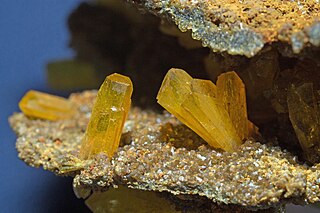
Legrandite is a rare zinc arsenate mineral, Zn2(AsO4)(OH)·(H2O).
Jarosewichite is a rare manganese arsenate mineral with formula: Mn2+3Mn3+(AsO4)(OH)6. It was first described in Franklin, New Jersey which is its only reported occurrence. Its chemical composition and structure are similar to chlorophoenicite. This mineral is orthorhombic with 2/m2/m2/m point group. Its crystals are prismatic or barrel-shaped. The color of jarosewichite is dark red to black. It has subvitreous luster of fracture surfaces and reddish-orange streak. This mineral occurs with flinkite, franklinite, andradite and cahnite.

Duftite is a relatively common arsenate mineral with the formula CuPb(AsO4)(OH), related to conichalcite. It is green and often forms botryoidal aggregates. It is a member of the adelite-descloizite Group, Conichalcite-Duftite Series. Duftite and conichalcite specimens from Tsumeb are commonly zoned in color and composition. Microprobe analyses and X-ray powder-diffraction studies indicate extensive substitution of Zn for Cu, and Ca for Pb in the duftite structure. This indicates a solid solution among conichalcite, CaCu(AsO4 )(OH), austinite, CaZn(AsO4)(OH) and duftite PbCu(AsO4)(OH), all of them belonging to the adelite group of arsenates. It was named after Mining Councilor G Duft, Director of the Otavi Mine and Railroad Company, Tsumeb, Namibia. The type locality is the Tsumeb Mine, Tsumeb, Otjikoto Region, Namibia.

Conichalcite, CaCu(AsO4)(OH), is a relatively common arsenate mineral related to duftite (PbCu(AsO4)(OH)). It is green, often botryoidal, and occurs in the oxidation zone of some metal deposits. It occurs with limonite, malachite, beudantite, adamite, cuproadamite, olivenite and smithsonite.

Lavendulan is an uncommon arsenate mineral in the lavendulan group. It is known for its characteristic intense electric blue colour. Lavendulan is very similar to Lemanskiite, the analogue trihydrate mineral, to the point of them being considered dimorphs. Lemanskiite is tetragonal, but lavendulan is monoclinic. Lavendulan has the same structure as sampleite, and the two minerals form a series. It is the calcium analogue of zdenĕkite and the arsenate analogue of sampleite.

Tsumebite is a rare phosphate mineral named in 1912 after the locality where it was first found, the Tsumeb mine in Namibia, well known to mineral collectors for the wide range of minerals found there. Tsumebite is a compound phosphate and sulfate of lead and copper, with hydroxyl, formula Pb2Cu(PO4)(SO4)(OH). There is a similar mineral called arsentsumebite, where the phosphate group PO4 is replaced by the arsenate group AsO4, giving the formula Pb2Cu(AsO4)(SO4)(OH). Both minerals are members of the brackebuschite group.
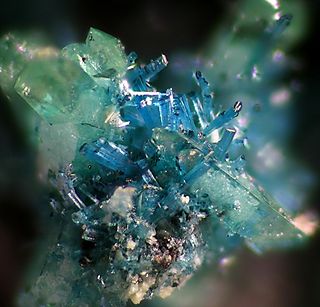
Keyite is a mineral with the chemical formula Cu2+3Zn4Cd2(AsO4)6 · 2H2O. The name comes from Charles Locke Key, an American mineral dealer who furnished its first specimens. Keyite is monoclinic-prismatic, meaning its crystal form has three unequal axes, two of which have 90° angles between them and one with an angle less than 90°. Keyite belongs to the biaxial optical class, meaning it has more than one axis of anisotropy, in which light travels with zero birefringence, and three indices of refraction, nα = 1.800, nβ, and nγ = 1.870. Being a very rare cadmium copper arsenate, keyite is only found in Tsumeb, Namibia in the Tsumeb mine, a world-famous copper mine known for its abundance of rare and unusual minerals.
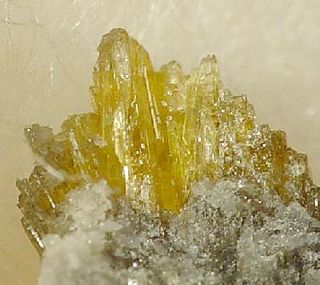
Warikahnite is a rare zinc arsenate mineral of the triclinic crystal system with Hermann-Mauguin notation 1, belonging to the space group P1. It occurs in the Tsumeb mine in Namibia on corroded tennantite in the second oxidation zone under hydrothermal conditions in a dolomite-hosted polymetallic ore deposit. It is associated with adamite, stranskiite, koritnigite, claudetite, tsumcorite, and ludlockite. The origin of discovery was in a dolomite ore formation within an oxidized hydrothermal zone, in the E9 pillar, 31st level of the Tsumeb Mine in Namibia, Southwest Africa. It has also been found at Lavrion, Greece and Plaka, Greece as microscopic white needles.

Tsumcorite is a rare hydrated lead arsenate mineral that was discovered in 1971, and reported by Geier, Kautz and Muller. It was named after the TSUMeb CORporation mine at Tsumeb, in Namibia, in recognition of the Corporation's support for mineralogical investigations of the orebody at its Mineral Research Laboratory.

Köttigite is a rare hydrated zinc arsenate which was discovered in 1849 and named by James Dwight Dana in 1850 in honour of Otto Friedrich Köttig (1824–1892), a German chemist from Schneeberg, Saxony, who made the first chemical analysis of the mineral. It has the formula Zn3(AsO4)2·8H2O and it is a dimorph of metaköttigite, which means that the two minerals have the same formula, but a different structure: köttigite is monoclinic and metaköttigite is triclinic. There are several minerals with similar formulae but with other cations in place of the zinc. Iron forms parasymplesite Fe2+3(AsO4)2·8H2O; cobalt forms the distinctively coloured pinkish purple mineral erythrite Co3(AsO4)2·8H2O and nickel forms annabergite Ni3(AsO4)2·8H2O. Köttigite forms series with all three of these minerals and they are all members of the vivianite group.

Carminite (PbFe3+2(AsO4)2(OH)2) is an anhydrous arsenate mineral containing hydroxyl. It is a rare secondary mineral that is structurally related to palermoite (Li2SrAl4(PO4)4(OH)4). Sewardite (CaFe3+2(AsO4)2(OH)2) is an analogue of carminite, with calcium in sewardite in place of the lead in carminite. Mawbyite is a dimorph (same formula, different structure) of carminite; mawbyite is monoclinic and carminite is orthorhombic. It has a molar mass of 639.87 g. It was discovered in 1850 and named for the characteristic carmine colour.

Serpierite (Ca(Cu,Zn)4(SO4)2(OH)6·3H2O) is a rare, sky-blue coloured hydrated sulfate mineral, often found as a post-mining product. It is a member of the devilline group, which has members aldridgeite (Cd,Ca)(Cu,Zn)4(SO4)2(OH)6·3H2O, campigliaite Cu4Mn2+(SO4)2(OH)6·4H2O, devilline CaCu4(SO4)2(OH)6·3H2O, kobyashevite Cu5(SO4)2(OH)6·4H2O, lautenthalite PbCu4(SO4)2(OH)6·3H2O and an unnamed dimorph of devilline. It is the calcium analogue of aldridgeite and it is dimorphous with orthoserpierite CaCu4(SO4)2(OH)6·3H2O.
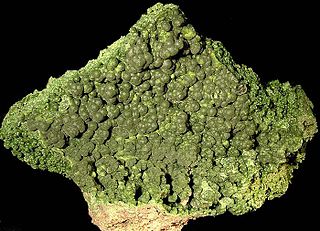
Mottramite is an orthorhombic anhydrous vanadate hydroxide mineral, PbCu(VO4)(OH), at the copper end of the descloizite subgroup. It was formerly called cuprodescloizite or psittacinite (this mineral characterized in 1868 by Frederick Augustus Genth). Duhamelite is a calcium- and bismuth-bearing variety of mottramite, typically with acicular habit.
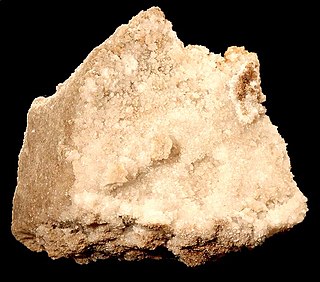
Talmessite is a hydrated calcium magnesium arsenate, often with significant amounts of cobalt or nickel. It was named in 1960 for the type locality, the Talmessi mine, Anarak district, Iran. It forms a series with β-Roselite, where cobalt replaces some of the magnesium, and with gaitite, where zinc replaces the magnesium. All these minerals are members of the fairfieldite group. Talmessite is dimorphic with wendwilsonite.
Bettertonite is a mineral of the arsenate category, named after John Betterton. He is a museum geologist and mineralogist at Haslemere Educational Museum in Surrey, England. Bettertonite is a white arsenate mineral with a formula of [Al6(AsO4)3(OH)9(H2O)5]・11H2O. Bettertonite is in the monoclinic system and has a heteropolyhedral layered structure type. It is a natural forming polyoxometalate. Bettertonite forms in clusters of radiating rectangular laths. Laths are thin and usually < 20 μm laterally. Laths are flat on {010}. Bettertonite is similar to penberthycroftyite and it transforms into penberthycroftyite at low temperatures (67–97 °C).

Arsendescloizite is a lead-zinc mineral, approved by the IMA in 1982. It is an arsenate analog of descloizite. Its first description was published in 1982.



















